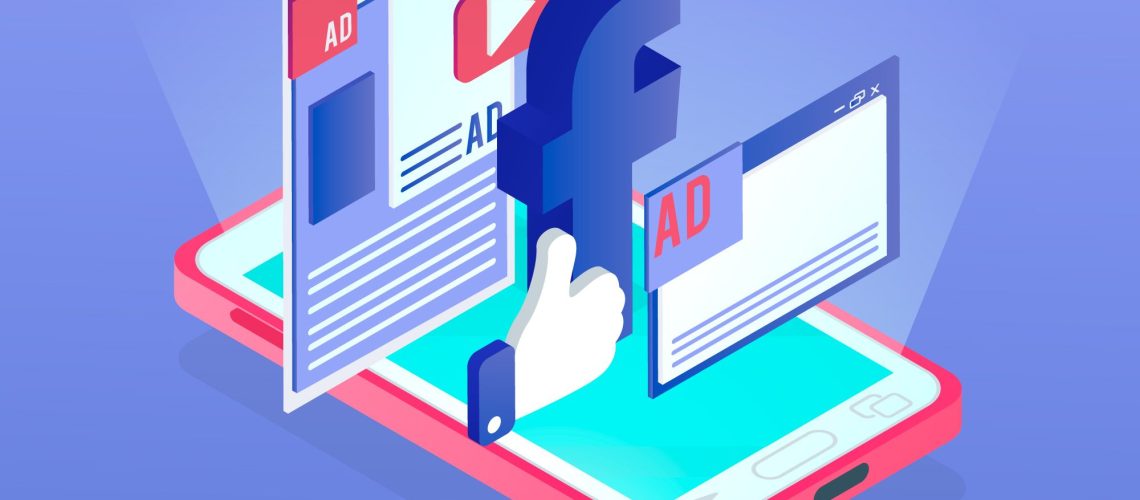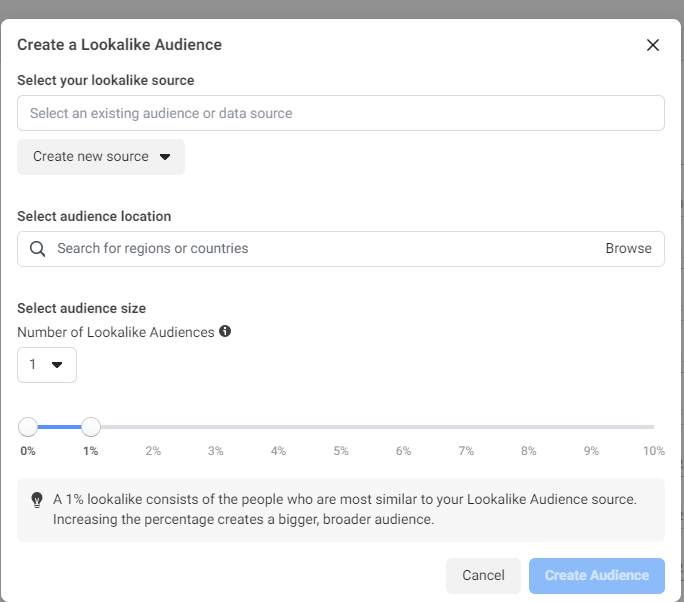Facebook ads targeting is very important when structuring ads because it can affect your ad campaign positively or negatively.
The major reason why brands run ad campaigns is for people to either buy their product or use their services.
But what happens when the wrong people are responding to your ad on Facebook?
Your cost per results increases and you don’t get the desired result you want, even when you get your desired result, it comes at a higher cost.
This is due to wrong targeting, you’ve targeted people who aren’t interested in what you have to offer.
But when you target people who are interested in buying your products and services, your cost per result decreases, thus, you get people interested in what you offer at a lower cost.
This is just as simple as your ad resonating well with them and they showed that by responding to it.
Facebook offers three (3) types of audience targeting options that you can use.
But before you can use these targeting tools, you must understand how they work and define who your ideal customers are for you to structure an effective targeting that will drive sales.
So, in this article, I will be explaining the three (3) targeting tools of Facebook and how you can use it to your benefit for your advertising campaign.
To learn how to define your ideal customers, you can read What Is A Customer Avatar | How To Create A Customer Avatar
What is Facebook Ad Targeting?
Facebook Ad targeting is the process of selecting specific criteria or parameters to define the audience you want to reach with your Facebook advertisements.
These criteria can include various factors such as demographics (age, gender, education, marital status), geographic location (country, city, proximity to a specific address), interests (hobbies, behaviors, preferences), and more.
Facebook Ad Targeting Strategy and Best Practices
Here are some best strategies and practices to adopt for you to have an effective advertising:
Get 50% Discount to Master ALL Aspects of Digital Marketing That Can Earn You $2,500 - $5,000 a month (Even if you are a complete beginner!)
Our students that intentionally implement what they learn from our digital marketing course make back the entire course fee within a single month or more after completing our course because our course gives them many income generating options with unlimited earning potential with no age or location barrier. The best part is no technical skills are required.
An opportunity to change your lifestyle and make money working from anywhere in the world. The results our students get from our digital marketing course prove this could be applied to any market or country and that it is designed for any skill level and work background.
*By signing up, you agree to our privacy policy and terms of service.
Audience Segmentation: Divide your audience into smaller segments based on the demographics, interests, behaviors, and purchase history of customers. Create tailored ads for each segment to increase relevance.
Ad Placement: Choose where your ads appear, whether it’s in the Facebook News Feed, Instagram, Audience Network, or the Facebook Marketplace. Each placement has its advantages.
Ad Scheduling: Optimize ad delivery by running campaigns at specific times when your audience is most active.
A/B Testing: Test different ad creatives, copy, and audience segments to determine which combinations yield the best results.
Exclude Irrelevant Audiences: Use exclusions to avoid showing your ads to audiences that are unlikely to convert, saving your budget for more promising prospects.
Use Video Content: Engage users with video ads, as they tend to have higher engagement rates.
Mobile Optimization: Ensure your ads are mobile-friendly, as a significant portion of users access Facebook on mobile devices.
Conversion Tracking: Set up conversion tracking to measure the success of your campaigns and optimize accordingly.
Budget Allocation: Allocate your budget strategically across different ad sets and campaigns, focusing more on those that perform best.
Ad Relevance Score: Keep an eye on your ad relevance score. Ads with higher relevance tend to perform better and cost less.
Ad Copy and Visuals: Craft compelling ad copy and use eye-catching visuals to capture users’ attention.
Monitor and Adjust: Continuously monitor the performance of your ads and make adjustments as needed. Facebook’s Ads Manager provides valuable insights int what is working and what is not for better performance.
What is Facebook Audience?
A Facebook audience comprises the individuals you aim to connect with through your ad. Businesses can take advantage of Facebook’s feature, allowing them to select the characteristics, locations, and interests of its users, ensuring that they receive the most fitting advertisements.
Facebook Ad Targeting Audience
People are increasingly interacting with businesses online, and these interactions are taking place across a wider range of devices each year.
For example, if a person needs new shoes, they may visit the website of a company whose shoes they like and go through the website for more information.
They may even visit a physical store to see how certain items fit before making a purchase on the website or at the physical store.
These interaction generates an intent signal which indicates where the buyer is in their purchasing process.
These signals are used by Facebook targeting tools to help you reach people in your audience at various phases and customize your adverts to them.
You’ll need data sources like the Facebook pixel, SDK, or Offline Conversions tool to use these products properly.
To advertise to large groups of people, you can use typical audience criteria like age, interest, behavior, or location.
However, it’s essential to understand the capabilities and limitations of Facebook ad targeting tools so that you can plan to take advantage of every opportunity.
Facebook ad targeting tool is a very powerful tool if used well and targeting occurs at the ad set level in ads manager, but if you are boosting a post directly from your page, you can define your audience on that page.
Facebook Ad Targeting Options (How Does Facebook Target Ads Work)
The competition for attention has become more intense as the digital space becomes more crowded with advertising.
As a result, it has never been more critical for brands and businesses to interact with customers in a direct and personal manner.
Customers want content that is specifically tailored to their preferences, and brands want to connect with customers in a more meaningful way.
Facebook offers three (3) major ad targeting options with lots of features for this purpose, ensuring that you can reach your target audience. And tell me, who doesn’t want a higher ROI for their investments in ads.
Core Audience (Saved Audience)
The core audience is the default targeting option on Facebook, it allows you to target or create an audience based on demographics, behaviors, interests, locations, and connections.
You can reach people based on the information they share on Facebook.
This type of audience is suitable for businesses that just started advertising on Facebook or businesses that want to source for a new audience.
Location
With this option, you can target people based on one or more countries, counties/regions/states, cities, postal codes, designated market areas etc.
You can also choose to include or exclude people you want to show your ads to.

You also have the option to choose people living in this location, people who recently were in this location, and people who have traveled to this location in recent times.

Age, Gender, and Language
Age: You can select the age range of people you think will find your ad relevant.
Gender: You can choose to show your ad to either men or women or you can pick ‘select all’ to show your ads to both men and women.
Language: Enter a language if you want to show your ads to people who use a language that isn’t common to your location; if not leave it blank.

Demographics based targeting
Demographics allows you to target and reach people based on particular traits such as education, financial (income), employment (work), relationship status, and life events. Also, you can determine if your target group is represented by parents of children of specific age
Each option offers features that you can use to define the demographics of your audience.

Interest-based targeting
This targeting option allows you to target people based on specific interests and hobbies such as activities, the pages they’ve liked, and closely related topics.
You can reach people based on business and industry, entertainment, family and relationships, fitness and wellness, food and drinks, hobbies and activities, shopping and fashion, sport and outdoors, and technology.
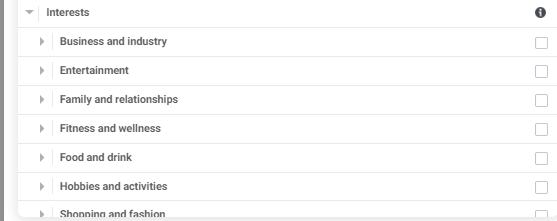
Each option offers features that you can use to define your audience base.
Behavior-based targeting
This targeting option helps you reach people based on their purchase habits, device usage, and other activities.
You can reach people based on different behavior options such as anniversary, consumer classification, digital activities, ex-pats, mobile device user, purchase behavior, etc.
Each option offers features that you can use to define your target audience.
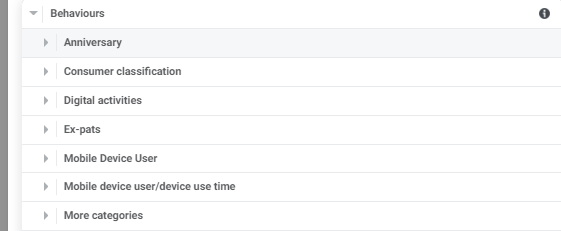
Connection
You can use this option to reach people who have a specific kind of connection to your page, app, or event.
You can also use this option to narrow the audience to include people with a specific connection you choose who also meet the other targeting options.


When using a core audience to structure your targeting; you can always type in your own suggestion to find the most suitable options to define your audience.
Custom audience
This targeting option helps you target people who have previously shown interest in your product or service, such as those people who looked at a product on your website but didn’t buy or target people based on the information you already have.
Custom audience, unlike core audience, only allows you to use information people share with Facebook. It allows you to securely protect the information you share and combine it with similarly confidential information on Facebook.
Custom Audiences can help you use the information you already have about your customers to target them on Facebook and Instagram and across various devices while maintaining audience privacy.
This method allows you to reach out to current clients on Facebook and Instagram while maintaining their privacy.
Custom Audiences allows you to leverage a variety of data sources which includes websites containing a pixel, customer lists, app activity (SDK), and offline activity, which are all examples of data sources (which includes engagement in-store and over the phone).
Facebook system can show your adverts to people who have demonstrated a specified level of interest or desire to buy your products or services using these sources.
Custom audience can help you achieve a wide range of business goals such as Customer acquisition, retention, and re-engagement.
For the best result, use high-quality data sources that are relevant to your goal.
High-quality data can help you raise the total number of persons in your Custom Audience who are matched.
There are two types of source on Facebook that you can use to create custom audience and these source include:
Custom audience from your source
To develop Custom Audiences, you can leverage on your CRM database, POS data, or email lists.
Use your website to communicate with current customers and others who have expressed an interest in your company.
People’s engagements with your apps or games reflect how engaged they are with your mobile activities.
Find people who are interested in your company offline such as in your store or over the phone.
With custom audience from your source, you can complement e-mail campaigns and target ads to people who don’t check their inboxes on a regular basis.
It can also be used to boost and strengthen a CRM message across social media platforms like Facebook and Instagram.
To measure the strength of your customer intent, you can use the pixel and SDK to focus on demonstrated purchase intent, such as frequency, recency, or time spent.
People can then be targeted with ads based on their specific actions.
For practical steps on how to create custom audience from your website through pixel or a custom audience from your customer list or offline activities, register for our 90% practical digital marketing course
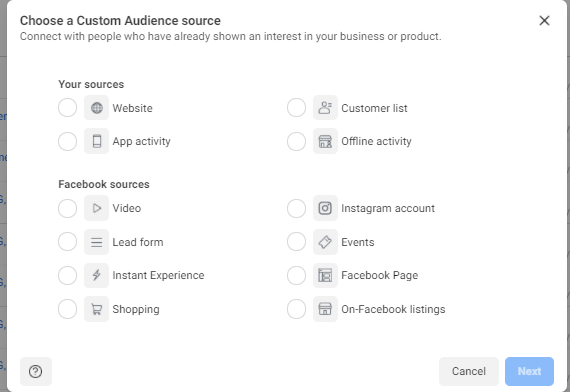
Custom audience from Facebook source
You can create a custom audience from Facebook source such as video.
Video: You can create an audience of people who watched one of your videos on Facebook and Instagram.
Lead Form: You can create an audience of people who have opened your instant experience on Facebook or Instagram
Instant Experience: You can create an audience of people who opened your instant experience on Facebook.
Shopping: You can create an audience of people who interacted with your products in a shopping experience on Facebook and Instagram.
Instagram account: You can create a custom audience of people who visited or interacted with your Instagram profile, posts, or ads. You will need a professional account which can either be a business or creator account.
Events: You can create a custom audience of people who have interacted with one of your events on Facebook.
Facebook page: You can create a custom audience of people who have interacted with one of your events on Facebook
Lookalike audience
You can use this targeting option to target new people who lookalike your present audience or customers for your advertisements.
It helps you market your product and services to people who have similar traits to those who have expressed interest in your product and services.
You can only create lookalike audience from a custom audience.
For example; imagine you are the owner of a store that sells women clothing and accessories and you primarily operates online.
Recently, you created and use a custom audience to retarget people who expressed interest in your product and services or have made purchases in the past on your website.
Now you want to attract new customers who don’t know about your product and services but you don’t know how to go about it.
But with a lookalike audience you can target new audiences who have similar characteristics with your existing customers.
This is because lookalike audience can help you find people who share demographics and behaviors with your current customers and deliver ads to them.
But to do this, you will need a source audience.
The source of the audience you select for your lookalike audience informs Facebook on which qualities to match.
Also, the audience size you choose in the creation process tells Facebook how closely the lookalike audience will match your source audience.
To do this, Facebook provides a scale from 1-10, which corresponds to the percentage you want Facebook to match with your seed audience.
Facebook usually recommend that you use a source audience between 1,000 and 50,000 people and the quality of the source audience should also be considered as it is very important.
A source audience is also know as a seed audience, this is where you derive your lookalike audience.
Targeting Issues You Should Avoid (Why are my Facebook Ads not Converting)
Effective targeting can increase your conversion while advertising on Facebook.
Likewise, poor targeting can lead to vice versa (poor or no conversion) which can result to audience fatigue (showing your ads multiple times to person). Below are a few things you should avoid to ensure your Facebook ads are converting.
Research your audience
Before you can decide which audience you want to show your ad to on Facebook, you must conduct thorough research to identify people who might be interested in purchasing your product or using your service.
Because if your ads are shown to the wrong people, there is no way they will be interested in your product or service, this will result in a higher cost.
People within your target audience will see your ad but they won’t take the desired action you want them to take.
Avoid audience overlap
This is the percentage of people who fall into both the audiences you’ve targeted with your ads.
Overlap isn’t always a bad thing, but it can be if you use both audiences at the same time.
It can also be problematic if the percentage of overlap and the budgets of the overlapping ad sets are sufficiently large.
To prevent audience overlap, you can use the Facebook overlap tools.
After creating your audience, you can check if your audiences are overlapping with each other
Use of audience exclusion
Customers who don’t need to hear your message may be excluded from your audience.
With Custom Audiences created from a customer list, you can, for example, exclude current customers from your CRM database.
You can create a custom audience of people who have visited your website and interacted with your Facebook or Instagram page.
When you employ a Custom Audience from your website, Facebook source, or mobile app, you can base the exclusion on a certain activity such as a purchase or any other activities people must have taken when they visited your website, page or app.
Facebook Audience Targeting Tools
1. Hootsuite Ads
2. Qwaya
3. AdStage
4. Facebook Ad Manager
5. AdEspresso
Conclusion
Targeting is one of the most important part of creating an ad on Facebook.
When your targeting is done right, you start getting your desired results at a very lower cost because people you’ve targeted would respond
well to your ad.
For more detailed practical steps on how to use Facebook targeting tool effective register for our 90% digital marketing course and get strategies you can start implementing to grow a highly successful business online.
Frequently Asked Questions
Why are my Facebook Ads not converting?
Several factors could contribute to your Facebook Ads not converting effectively. Here are some common reasons:
Poor Targeting: Your ads may not be reaching the right audience. Ensure your targeting parameters, such as demographics, interests, and behaviors, align with your ad’s message and offer.
Irrelevant Ad Content: If your ad doesn’t resonate with your audience or fails to provide a clear value proposition, it’s less likely to convert. Make sure your ad content is compelling and relevant to your target audience.
Unoptimized Landing Page: If the landing page users reach after clicking your ad is slow to load, confusing, or doesn’t fulfill the promise made in the ad, conversions will drop. Ensure your landing page is optimized for user experience and relevance.
Ad Fatigue: Displaying the same ad to the same audience repeatedly can lead to ad fatigue, causing users to ignore or hide your ads. Rotate ad creatives or refresh your ad content regularly to combat this.
Ineffective Ad Design: The visual and creative elements of your ad, including images and copy, play a crucial role in conversions. A visually appealing and informative ad is more likely to convert.
Budget Constraints: A limited budget may restrict the reach and frequency of your ads. Adjust your budget to match your campaign goals and the competition in your industry.
Timing and Frequency: The timing of your ads and the frequency with which they’re shown can impact performance. Test different schedules and ad delivery settings to find the optimal combination.
What is the Best Target for Facebook Ads?
The best target for Facebook ads depends on your business goals and the specific audience you want to reach. For national-level targeting, an audience size between 1 to 2 million people is recommended. For cold prospecting audiences or lookalike audiences, an optimal size is between 1-5 million people
What is the Minimum Audience Size for Facebook Ads?
The minimum audience size for Facebook ads varies depending on the campaign objective and targeting strategy. However, it is generally recommended not to go below 1 million in audience size and not above 10 million, especially when you’re first starting out.
How do I Increase Targeting on Facebook Ads?
To increase targeting on Facebook ads, consider using the following strategies:
- Use Lookalike Audiences: Create lookalike audiences based on your existing customer base to reach people with similar characteristics.
- Utilize Custom Audiences: Create custom audiences by uploading your customer lists or website traffic to target people who have already interacted with your brand.
- Leverage Detailed Targeting: Use detailed targeting options to narrow down your audience based on specific interests, behaviors, and demographics.
- Test Different Audiences: Experiment with different audience segments to identify the most effective targeting options for your ads.
Other Relevant Articles:
Facebook Advertising: How To Do Facebook Ads In 10 Steps
How To Use Facebook Ads Manager: What You Need To Know

